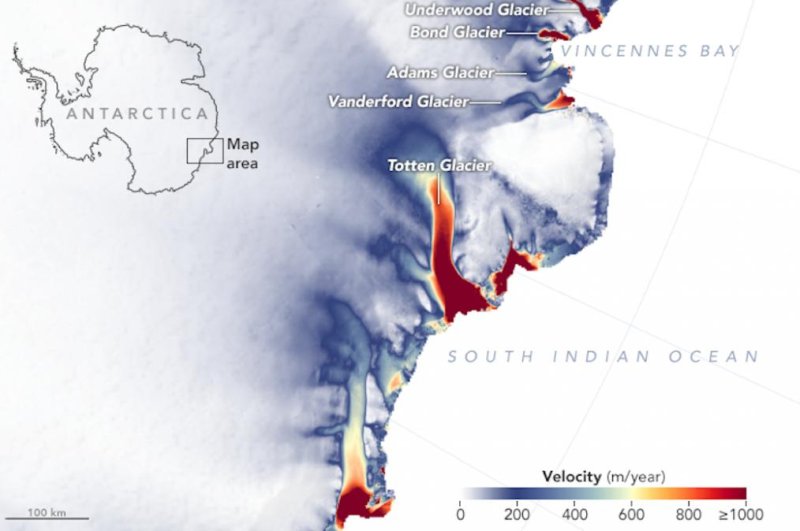Scientists have discovered a new group of shrinking glaciers along Antarctica's east coast. Photo by NASA/Earth Observatory
Dec. 10 (UPI) -- Scientists have identified a new group of melting glaciers on Antarctica's east coast, long thought to be the most stable of the continent's frozen coasts.
The fastest-moving ice in East Antarctica is found on Totten Glacier. Previous studies have revealed accelerated melt rates on Totten, the result of an influx of warm ocean water.
Newly analyzed satellite data suggests Totten is not alone.
"Totten is the biggest glacier in East Antarctica, so it attracts most of the research focus," Catherine Walker, a glaciologist at NASA's Goddard Space Flight Center, said in a news release. "But it turns out that other nearby glaciers are responding in a similar way to Totten."
When scientists used computer models and new satellite data to analyze ice movement along Antarctica's east coast, they found the height of four glaciers to the west of Totten, along Vincennes Bay, have dropped nine feet. The analysis showed several smaller glaciers to the east, along the Wilkes Land coast, are also shrinking.
Researchers at NASA used their models to build maps detailing East Antarctica's shrinking glaciers.
The levels of ice loss measured on the East Coast are still small compared to melt rates observed in West Antarctic, but scientists are concerned the new data of a shift in the East Coast's dynamics.
"This change doesn't seem random; it looks systematic," said Alex Gardner, a glaciologist with NASA's Jet Propulsion Laboratory. "And the systematic nature hints at underlying ocean influences that have been incredibly strong in West Antarctica. Now we might be finding clear links of the ocean starting to influence East Antarctica."
In addition to mapping East Antarctica's ice loss, researchers modeled ocean temperature patterns using data collected by sensor-tagged marine mammals and Argo floats. The analysis showed shifting wind patterns have driven warm water inland along Wilkes Land and Vincennes Bay.
Encroaching warm water has also been blamed for ice loss on Antarctica's west coast.
If East Antarctica begins to lose ice at a pace similar to West Antarctica, low-lying coastal cities around the world could become increasingly flooded.
"Those two groups of glaciers drain the two largest subglacial basins in East Antarctica, and both basins are grounded below sea level," Walker said. "If warm water can get far enough back, it can progressively reach deeper and deeper ice. This would likely speed up glacier melt and acceleration, but we don't know yet how fast that would happen. Still, that is why people are looking at these glaciers, because if you start to see them picking up speed, that suggests that things are destabilizing."















